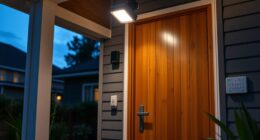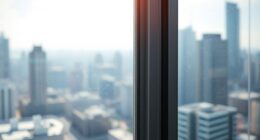Home security systems can cost anywhere from $200 to over $1,200, depending on what you need. Basic DIY systems start around $200, while professional installations can range from $800 to $1,600. Monthly monitoring fees vary too, typically costing between $10 and $60. Factors like equipment quality, installation method, and brand reputation also influence the overall price. If you consider a system, think about your budget and specific needs. There are options to save, like DIY installations or self-monitoring plans. Stick around to find out more about the best choices for your situation!
Key Takeaways
- The average cost of a home security system is approximately $490, potentially exceeding $1,200 with equipment, installation, and monitoring included.
- Equipment costs can range from $140 to $600, with comprehensive systems priced between $200 and $1,200.
- Installation costs vary, with DIY options costing $0 to $200 and professional services ranging from $100 to $400.
- Monthly monitoring fees typically range from $10 to $60, with self-monitoring options starting as low as $2.99 per month.
Average Costs of Home Security Systems
When contemplating a home security system, you can expect to pay around $490 on average, with options ranging from budget-friendly self-installations to higher-end professional setups.
The average cost of equipment alone typically falls between $140 and $600, depending on the features you choose. If you're leaning toward a DIY approach, you can save on installation costs since you won't incur additional fees. However, if you opt for professional installation, be ready for extra costs that can range from $100 to $400, which can greatly impact your total expenditure.
In addition to the upfront costs, monthly monitoring fees are another vital factor to evaluate. If you prefer self-monitoring, you might pay around $10 a month. On the other hand, professional monitoring services usually range between $22 and $60 monthly, adding to your long-term expenses.
With all these factors combined, the total cost of a thorough home security system—including equipment, installation, and monitoring—can exceed $1,200, depending on the features and services you select. It's essential to take these costs into account when planning your budget for home security.
Breakdown of Costs

Understanding the breakdown of costs for a home security system reveals how various components contribute to your overall investment. When evaluating your budget, consider the different types of expenses involved, including the initial setup and ongoing fees.
Here's a concise overview of the key costs:
| Cost Component | Estimated Cost |
|---|---|
| Equipment (basic to advanced) | $200 – $1,200 |
| Installation (professional vs DIY) | $0 – $400 |
| Monthly Monitoring Fees | $10 – $60 |
Initial equipment costs can range from $200 for basic systems to over $1,200 for thorough setups. If you prefer professional installation, be prepared for fees between $100 and $400; DIY installations can save you this cost.
Additionally, expect monthly fees for professional monitoring services, which typically range from $10 to $60. Keep in mind that activation and permit fees may also apply, adding to your total investment. By understanding these costs, you can make an informed decision about the security system that best fits your needs and budget.
Types of Home Security Systems

Home security systems come in various types, each offering unique features and benefits to suit different needs and budgets. Understanding these types can help you make an informed decision about what's right for your home.
- Wired Systems: Typically require professional installation, costing between $800 and $1,600. They provide reliable security but can be more expensive upfront.
- Wireless Systems: Easier to install and range from $200 to $2,000. These systems offer flexibility and can be set up without professional help.
- DIY Security Systems: Starting around $200, you can install and monitor your system independently. This option is budget-friendly and allows for customization.
- Monitored Systems: Provide 24/7 oversight by professionals, often incurring monthly fees of $22 to $60. This option guarantees immediate response in emergencies.
When choosing between types of home security, consider whether you want professional monitoring or prefer the independence of a DIY security system.
Each option has its pros and cons, so evaluate what fits your lifestyle and budget best.
Installation Methods and Costs

Choosing the right installation method for your home security system can greatly impact your overall costs and convenience. You have two main options: DIY installation or professional installation. DIY installation can save you money, typically costing between $0 and $200. Many systems, like Ring and Frontpoint, offer easy self-installation, making it accessible even if you're not tech-savvy. On the other hand, professional installation comes with higher installation fees, ranging from $280 to $1,150, depending on the provider and complexity of the system.
Here's a quick comparison of installation costs for popular brands:
| Brand | DIY Installation Cost | Professional Installation Cost |
|---|---|---|
| Abode | $0-$200 | $99 |
| ADT | $0-$200 | $99 |
| SimpliSafe | $0-$200 | $124.99-$254.97 |
| Brinks | $0-$200 | Free |
| Vivint | $0-$200 | Free |
Ultimately, your choice between DIY and professional installation will depend on your budget and comfort level. Remember, professional services often include extra monitoring and setup support, which can be beneficial.
Monthly Monitoring Options

After deciding on your installation method, it's crucial to explore the various monthly monitoring options available for your security system. Monthly payments for monitoring services can vary widely, so it's important to find a plan that fits your needs and budget.
Here's a quick overview of options you might consider:
- Self-Monitoring: If you prefer a hands-on approach, services like Wyze offer plans starting as low as $2.99 per month.
- Basic Professional Monitoring: Companies like Ring provide flexible plans ranging from $4.99 to $20 per month, depending on the features you choose.
- Comprehensive Professional Monitoring: For robust security, Frontpoint's plan is at the higher end, starting at $49.99 per month, offering extensive services.
- Flexible Contracts: SimpliSafe offers no long-term contracts with monitoring fees as low as $29.99, giving you flexibility in managing your security costs.
Understanding these options helps you gauge what kind of monitoring service aligns with your security needs and budget, ensuring you get the best protection for your home.
Factors Influencing Pricing

When you're considering a home security system, several factors will influence the pricing.
The quality of the equipment you choose, the method of installation, and the type of monitoring service you select all play significant roles in determining your total cost.
Understanding these elements can help you make an informed decision that fits your budget and security needs.
Equipment Quality Impact
Equipment quality plays an essential role in determining the cost of home security systems, with advanced features often leading to higher prices. When you're considering your options, keep in mind that investing in higher-quality equipment can enhance your home's safety.
Here are some factors that influence pricing based on equipment quality:
- Technology Level: Premium systems often include advanced technology like smart home integration and high-definition cameras, which can greatly increase costs.
- Brand Reputation: Established brands like ADT and Vivint charge more for their equipment, averaging around $600, while DIY brands like Ring start as low as $139.99.
- Number of Devices: The more cameras and sensors you need for larger homes, the higher your overall cost will be.
- Special Features: Additional features, such as environmental sensors for smoke or carbon monoxide detection, can also raise the price of your system.
Installation Method Choices
Choosing the right installation method can markedly impact the overall cost of your home security system, whether you opt for a DIY approach or professional assistance. DIY options usually start around $200, making them a more budget-friendly choice. However, if you prefer professional installation, costs can range from $280 to $1,150, depending on the complexity of the system and the provider you choose.
Here's a quick comparison of some installation costs:
| Provider | DIY Installation | Professional Installation |
|---|---|---|
| Abode | Starting at $200 | $99 |
| ADT | Starting at $200 | $99 |
| SimpliSafe | Starting at $200 | $124.99 – $254.97 |
Keep in mind that larger homes may incur higher installation costs due to the need for additional equipment. Also, the choice between wired and wireless systems plays a significant role in expenses, with wired systems costing between $800 and $1,600. So, weigh your options carefully to find the best fit for your budget and security needs.
Monitoring Service Options
Monitoring service options considerably influence the overall cost of your home security system, with choices ranging from self-monitoring to professional services. Depending on your needs and budget, you can select a monitoring plan that suits you best.
Here's a breakdown of typical monthly costs:
- Self-Monitoring: Ranges from $4.99 to $10 per month, with platforms like Ring offering affordable options.
- Professional Monitoring (Basic): Usually between $22 and $35 per month, providing reliable service.
- Premium Professional Monitoring: Some services, like Frontpoint, offer plans up to $49.99 per month for enhanced features.
- High-End Professional Monitoring: Companies such as Vivint charge between $40 to $60 per month, focusing on thorough security.
Choosing between self-monitoring and professional monitoring greatly impacts your home security's effectiveness. While self-monitoring may save you money, professional services provide immediate emergency dispatch in case of alerts, ensuring a quicker response when you need it most.
Ultimately, weigh your options carefully to find the best monitoring solution for your home.
Benefits of Home Security Systems

When you invest in a home security system, you're not just enhancing your safety; you're also accessing potential savings.
Many insurance companies offer discounts on premiums, which can make a significant difference in your budget.
Plus, with professional monitoring, you get quick emergency response capabilities, giving you peace of mind whether you're home or away.
Enhanced Safety Measures
Why risk your safety when home security systems offer proven benefits that considerably reduce the likelihood of break-ins? With homes equipped with these systems being 300% less likely to face burglary, investing in enhanced security measures is a smart choice.
Here are some key advantages:
- Professional Monitoring: With rapid emergency response times averaging between 30 to 45 seconds, you'll have peace of mind knowing help is just a call away.
- Deterrent Effect: The mere presence of security cameras can deter 83% of potential burglars, showcasing the psychological impact of visible security.
- Remote Monitoring: Stay connected to your property in real time, allowing you to monitor activity and respond swiftly to any unusual situations.
- Smart Home Integration: Enhance your security by integrating your system with smart devices, giving you greater control over your home's safety.
Insurance Premium Discounts
Installing a home security system can lead to considerable discounts on your homeowners insurance premiums, saving you money while enhancing your property's safety. Many insurance companies offer savings of up to 20% for policyholders who opt for monitored systems. They view these systems as effective risk mitigation measures, which can lower the chances of theft or damage claims.
When you install security features like alarms and cameras, you may qualify for additional discounts beyond standard policy rates. It's essential to keep in mind that insurers typically require proof of installation or monitoring services to apply these premium discounts. This means you'll need to provide documentation to your insurer after setting up your system.
Regularly reviewing your insurance policy is a smart move, as it allows you to take full advantage of available discounts related to your home security measures. By staying informed and proactive, you can maximize your savings while ensuring your home remains secure.
Emergency Response Capabilities
Home security systems equipped with emergency response capabilities provide an essential layer of protection, guaranteeing rapid assistance during critical situations. When an alarm triggers, professional monitoring services can respond within 30 to 45 seconds, offering immediate support.
These systems often include advanced features such as key factors in choosing a home cleaning service that enhance overall security and convenience. Here are some key benefits of these systems:
- Quick Response: Professional monitoring guarantees that emergency responders are contacted promptly, minimizing response time.
- Video Verification: Many systems feature video verification, allowing monitoring centers to assess the situation in real-time before dispatching help, improving accuracy.
- Burglar Deterrent: Approximately 83% of burglars are deterred by the presence of security systems, particularly those with emergency response capabilities.
- Integrated Environmental Sensors: Systems equipped with sensors for smoke and carbon monoxide can automatically alert emergency services, potentially saving lives in critical situations.
Investing in a home security system not only enhances your peace of mind but also guarantees that help is always just a moment away.
With the combination of professional monitoring services and advanced technology, you can feel secure in knowing that your home is protected around the clock.
Money-Saving Tips

You can save considerably on home security by exploring DIY installation options and self-monitoring plans.
Installing your system can eliminate installation fees that typically range from $100 to $400, which home security companies usually charge for professional services.
Additionally, self-monitoring plans often cost around $10 per month, while professional monitoring can set you back between $22 and $60 monthly.
Another smart move is to look for bundled service deals and promotions from security companies.
These offers can lead to significant savings on both equipment and monitoring costs.
Also, take a moment to evaluate your security needs and select only the necessary features.
Cutting unnecessary add-ons helps reduce both initial and ongoing expenses.
Considerations for Choosing a System

When selecting a security system, it's essential to evaluate your specific needs and budget to make an informed decision. The cost of home security can vary widely, so you'll want to take into account several key factors:
- Type of System: Decide between wired and wireless systems; wired systems typically range from $800 to $1,600, while wireless options start around $200.
- Installation Method: Choose between DIY installation, which is cheaper, or professional installation, which can cost between $100 and $1,150.
- Monthly Monitoring Fees: Factor in the ongoing costs; self-monitoring averages about $10/month, while professional monitoring can be anywhere from $22 to $60/month.
- Additional Features: Think about extras like smart home integration or additional cameras, which can elevate your total expenses.
Frequently Asked Questions
How Much Does the Average Person Spend on Home Security Systems?
You'll likely spend around $490 on a home security system, but prices vary. Basic DIY options start at $200, while professional installations can reach $600 or more, depending on features and monitoring services. Additionally, the cost can fluctuate based on whether you opt for extra components like cameras, motion detectors, or smart home integration. For example, the Brinks home security system cost typically falls within the mid-range, offering both DIY and professional installation options. Keep in mind that ongoing monitoring fees can further impact your overall budget, with prices ranging from $10 to $50 per month depending on the level of service.
How Much Does It Cost to Add a Home Security System?
When you consider adding a home security system, you'll weigh equipment costs, installation fees, and monitoring expenses. DIY options might save money, while professional setups offer reliability but often come with higher price tags.
How Much Does It Cost to Put an Alarm System in Your House?
To put an alarm system in your house, you'll typically spend between $200 for DIY setups and $600 for professional installations. Don't forget to factor in monitoring fees and potential activation costs.
Is It Worth It to Get a Home Security System?
Absolutely, getting a home security system's worth it. It considerably deters burglaries, offers peace of mind, and can even lower your insurance premiums. You're investing in safety, making your home a more secure place.
Conclusion
In the grand tapestry of home safety, investing in a security system is a wise choice that offers peace of mind and protection.
While costs can vary, the benefits often outweigh the price tag.
By understanding your options and taking advantage of money-saving tips, you can find a solution that fits your budget without compromising safety.
Ultimately, safeguarding your sanctuary isn't just a transaction; it's an embrace of security that wraps your home in comfort and assurance.









